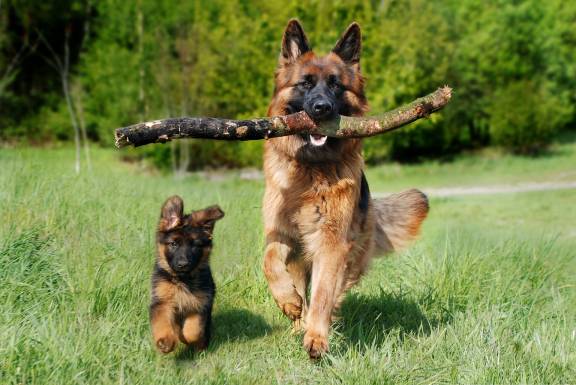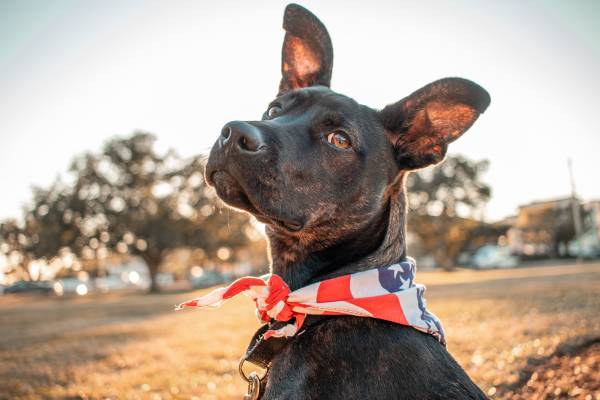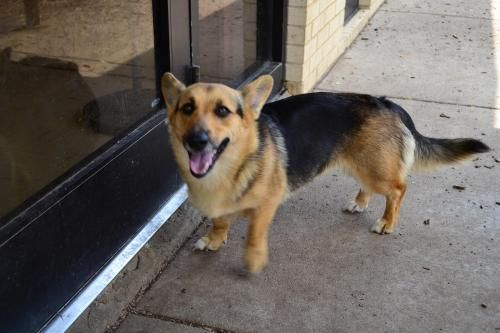Connect with a verified veterinarian in minutes. Licensed vets are available 24/7 to answer your questions. No need to worry about your furry family member.
Have you heard of the Dane Shepherd dog breed? If not, you’re not alone! This was a new one for us, too! However, if you’re looking to adopt a beautiful, large dog you may want to consider the Dane Shepherd!
We’ve put together some information about this dog breed to help you decide if this is the right dog for you!
What is a Dane Shepherd?
A Dane Shepherd is a hybrid dog (sometimes also called a designer dog). This hybrid dog breed is the result of crossing a purebred Great Dane with a purebred German Shepherd. The result? The Dane Shepherd is a very large dog that makes a great watchdog! However, they’re also great with kids and other pets and are wonderful family companions.
No one is completely sure about when the Dane Shepherd was first developed. It’s thought they may have first been bred by breeders in the 1990s. That was a time when dog breeders were experimenting with crossing different purebred dog breeds to develop a better, healthier dog.
While we don’t know much about the history of the Dane Shepherd, we do know quite a bit about both purebred parents!
The Great Dane is a giant dog breed that may date back to ancient times. Pictures of dogs that strongly resemble Great Danes have been found on Egyptian artifacts dating to 3000 BC! Images of similar dogs have also been found in Babylonia, Tibet, and China, all dating back thousands of years.
It’s thought Assyrians traded these dogs to Greeks and Romans. The Greeks and Romans then bred the dogs with other breeds, possibly even leading to the mastiff-type dogs. In England, Great Danes were bred to be boar hunters, so you know these were brave dogs!
On the other hand, German Shepherds are a newer dog breed that dates back to the late 1800s. They were first developed by Captain Max von Stephanitz. He wanted to develop a German dog breed that would make the best herding dog ever.
Later, the dogs were used in WWI by the German government. These dogs were also used by the Red Cross as messengers, rescuers, guards, sentries, and supply carriers. German Shepherds eventually were brought to the US after WWI, where they’ve been popular ever since.
So, the purebred parents of the Dane Shepherd are both working dogs! However, both the German Shepherd and the Great Dane also make wonderful family companions.
Dane Shepherd Dog Appearance
When it comes to a hybrid dog breed’s appearance, it’s important to understand some basics about genetics. A hybrid dog is not a 50/50 copy of the purebred parents. Many people have this mistaken idea and are surprised by the wide variations in characteristics of hybrid puppies. But this is just normal. The reason is that a dog’s genetics are randomly inherited from his parents.
In the case of the Dane Shepherd, the dog may look more like his Great Dane parent or more strongly resemble his German Shepherd parent. It just depends on the genes he inherits. Even in a litter of puppies, none of them will be exactly identical. Some may look more like Great Danes, while others loo more like German Shepherds. There could also be puppies who look like both parents! You just never know.
So, what will a Dane Shepherd look like? It’s hard to say, but we can get some ideas from the parents. For instance, it’s a good bet the dog will be a giant dog since both parents are large or giant dogs. A Dane Shepherd could stand between 28 to 30 inches tall and weigh between 65 to 130 lbs.
Most of these dogs will have long legs, with long, muscular bodies and longer ears. The dog’s coat may be more like the Great Dane’s, which is shorter. It’s also possible the hybrid dog could have a medium-length coat.
When it comes to coat color, there’s a wide variety of shades that may come out in Dane Shepherds. The colors most common in these dogs are red, tan, black, cream, grey, sable, fawn, silver, harlequin, and merle.

Review symptoms, medications & behavior to keep your pets healthy with a Vet Online in just minutes.
Ask a Vet Live NowDane Shepherd Temperament
As with other characteristics, it’s impossible to accurately predict the hybrid dog’s temperament. However, we can look at the dog’s parents to see what his personality and temperament may be.
The good news is that the Dane Shepherd is usually a great dog for families, as long as they have the space for these giant dogs!
Dane Shepherds are highly intelligent and beautiful. They can also be easy to train as long as the pet parent is able to establish themselves as dominant in the home. These dogs are also very alert and protective. They will do what’s necessary to protect their family and property, too.
These dogs are very affectionate and need plenty of attention from their pet parents and families. For this reason, it’s best not to leave these dogs alone for long periods. They can become bored and/or develop separation anxiety. Dogs who have separation anxiety may become destructive or develop other negative behaviors.
Do Dane Shepherds Get Along with Kids and Other Pets?
Dane Shepherds are very playful and gentle with kids; however, because of their giant size, these dogs should not play with younger children. The dog could accidentally cause an injury without meaning to. However, no dog should ever be left unattended with kids—it’s best to always supervise kids and dogs when they’re playing together.
Fortunately, Dane Shepherds can also get along with other pets. However, the dogs must be properly trained and socialized from a young age in order to get along with other pets.
Dane Shepherd Care
When it comes to caring for these dogs, the Dane Shepherd usually takes after his Great Dane parent. That means the dogs have a short or medium coat. They need to be brushed about once a week to keep their hair clean and shiny.
These dogs do shed; however, they shed even more about twice a year (in the spring and fall). During this time, you’ll want to brush your fur baby outside, if possible. That way, the fur will end up out there, where it’s easier to clean up. Brushing your dog in the house can lead to the fur being dragged and spread all over the furniture, on clothes, and more!
When it comes to bathing, a Dane Shepherd only needs to have a bath once in a while. If your fur baby becomes dirty and stinky, then it’s time for a bath. If he becomes stinky in between baths, then dog deodorizing wipes may help control his odor and keep him clean.
In addition, bathing your fur baby too often can strip the dog’s coat of its natural oils. This can lead to dry, irritated skin that may be prone to infections.
And if your fur baby has floppy ears, then these need to be checked regularly. The problem is that floppy ears can trap dirt, debris, and even pests inside. These can lead to infections not being cleaned out regularly.
Food & Diet Requirements
Dane Shepherds don’t have any specific dietary needs. However, they do best on high-quality commercial dog food that’s made for giant, active dogs. They do best on a high protein diet and dog food that offers joint support. These are giant digs that can develop joint problems, so it’s best to look for a dog formulated to support their joints, too.
However, the Dane Shepherd can develop gastric dilatation and volvulus, which means the stomach can distend and flip. For this reason, Dane Shepherds should be fed several small meals throughout the day, rather than one or two larger meals.
These large dogs require a lot of food to stay healthy! They need between five to ten cups of food each day.
Exercise Requirements
Dane Shepherds are very active dogs, though it may depend on the dog’s genetics. For instance, while German Shepherds have a ton of energy, Great Danes are a little more easygoing. So, it’s possible for a Dane Shepherd to be somewhere in the middle. Still, each dog will vary slightly.
What is for certain is that these dogs need to be exercised on a regular basis. They need at least 60 minutes of exercise a day. This can include walks, playtime, and more. When dogs don’t receive the amount of exercise they need, it’s possible they may become bored. In that situation, the dog will find ways to get rid of his energy. That means he may become destructive and chew up everything in sight. It’s also possible the dog may develop negative behaviors. So, be sure to exercise your Dane Shepherd every day. This is crucial to his physical and mental health.
Speaking of mental health, a Dane Shepherd also requires plenty of mental stimulation. These dogs are smart, and you don’t want them to become bored. For this reason, you may want to consider enrolling your fur baby in agility courses, obedience training, and other activities. This way, your dog has the best of both physical and mental stimulation.
Training
The Dane Shepherd can be somewhat challenging to train. They’re highly intelligent, which means they learn easily and quickly! However, the Great Dane parent may have gifted some of their stubbornness to the dog.
German Shepherds and Great Danes do best with pet parents who are more experienced and know how to handle these dogs. The pet parent must ensure the dog understands the pet parent is in charge. If the dog thinks he’s the dominant one, your entire household will be run according to the dog’s rules! You don’t want to go against a large dog’s rules! So, make sure you know how to properly handle these dogs. They do best with positive reinforcement training methods and plenty of socialization.
Health Issues
Dane Shepherds are hybrid dogs that get their genes from both parents. That means they may also inherit the health conditions that come from their parents’ breeds. Dane Shepherd mixes can suffer from the following health conditions:
- Exocrine pancreatic insufficiency
- Diabetes
- Cardiomyopathy
- Cancer
- Hip dysplasia
- Allergies
- Eye conditions
- Skin infections
Even so, the Dane Shepherd has a life expectancy between eight to thirteen years.
One of the best ways to keep your Dane Shepherd healthy is to take him to the vet for regular checkups. Many health conditions are easier to treat when they’re caught early. Ensuring your fur baby has all his vaccinations can also keep him healthier.
In addition, you may want to consider pet health insurance for your Dane Shepherd. There are many pet health insurance policies on the market today. Some cover a wide range of services such as regular checkups, vaccinations, emergencies, and more. If your dog becomes seriously ill, you’ll have financial assistance from the pet health insurance policy. You can then rest easier, knowing you’re prepared in case the worst does happen.
Where to Find a Dane Shepherd?
One of the best places to find a Dane Shepherd is from a reputable breeder. These are breeders who love their dogs and the breeds they’re working with. In addition, reputable breeders test their dogs and puppies for health conditions and behavioral issues that can cause problems in the dogs.
Another place to find Dane Shepherds is from a shelter or rescue. These dogs need and deserve loving homes as much as any other dogs.
How Much Does a Dane Shepherd Puppy Cost?
The Dane Shepherd can cost between $400 to $850 if you adopt from a reputable breeder. If you adopt your canine companion from a shelter, the cost can run between $100 to $300.
In addition, dogs that are adopted in the city are usually more expensive, while dogs adopted from smaller towns and rural areas are cheaper.
Summing It Up
Dane Shepherds are giant dogs that do best in a large home with a large, fenced yard. They’re adorable, loving, and make great watchdogs, too!
If you have the time and the space for a dog this size, then a Dane Shepherd may be the right dog breed for you!
Connect with a verified veterinarian in minutes. Licensed vets are available 24/7 to answer your questions. No need to worry about your furry family member.

Kim
Kim is a talented author, who loves animals especially dogs. She engaged in writing books and articles relating to animals a decade ago. Kim resides in Chicago with her husband and son. The family is the proud owner of a dog and a parrot (Jack and Lily). Kim wanted more than these two pets, but her husband put his foot down... She often visits elementary schools to talk to the kids about what she learned about pets and how they could learn from them.
Review symptoms, medications & behavior to keep your pets healthy with a Vet Online in just minutes.
Ask a Vet Live Now




